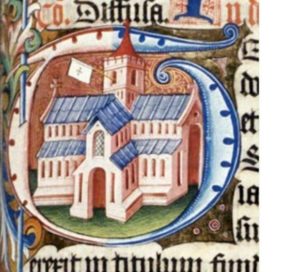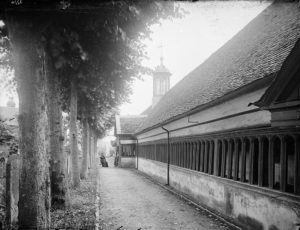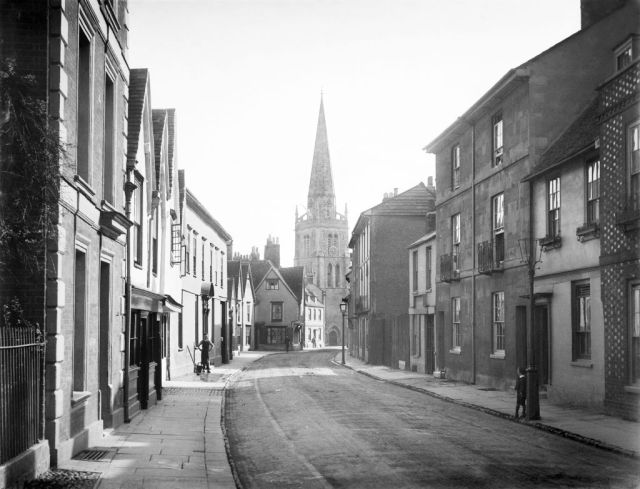East St Helen Street in Abingdon looks much the same as it did in 1890. Credit: English Heritage/Heritage Images/Getty Images

If you were asked to guess the oldest town in Britain, you might not think of Abingdon. But the market town, which lies six miles south of Oxford, claims — and with some justice — to be the “oldest continuously occupied town” in this country. Situated on a loop of the Thames, in a green river valley, Abingdon was a densely-occupied and well-defended settlement by the Iron Age, surrounded by ditches which can still be traced in the plan of the modern town. Throughout the Roman and early Anglo-Saxon periods, the town’s population persisted, and by the tenth century had become the site of an important monastery.
Tourists who come to Oxford from around the world rarely make their way to Abingdon; it’s a working town, not a showplace. Its central shopping area was a casualty of post-war planners, a mass of modern concrete and chain stores; to the north, new housing estates are creeping ever closer to the famous university city. What might have been Abingdon’s chief tourist attraction, its cathedral-like abbey church, was destroyed five centuries ago.
And yet few towns are better proof of just how long and rich the history of apparently ordinary places can be. The two caveats in Abingdon’s claim to longevity (“town”, rather than city, and “in continuous occupation”) are significant, because it’s in these smaller communities — and the remarkable continuity of their institutions and collective lives — that the bedrock of British history lies.
The monks of Abingdon were making books and writing history centuries before any scholars came to settle in Oxford. One of the most influential figures in the late Anglo-Saxon church, St Æthelwold, was abbot here in the tenth century. A vigorous and industrious man — and a champion of educational and religious progress — Æthelwold didn’t spend long at Abingdon. But it still bears traces of the work he did to build up the abbey: a stream in the town, once the abbey millstream, follows the course Æthelwold and his monks set for it a thousand years ago. They may have been copying the line of the prehistoric defences, already ancient by Æthelwold’s time.
Æthelwold and his fellow abbots were running a school at Abingdon when Oxford was just a crossing-place over the Thames. But by the twelfth century, when Abingdon’s most famous son was born, the balance was already beginning to shift. Abingdon’s own saint, Edmund, was born into a middle-class family in the town around 1174. His mother wanted him to be well-educated, so she sent him not to the abbey but to school in Oxford, which by that time was gathering the communities of teachers and students who would form the nucleus of the university.
A devout and studious boy, Edmund made the most of his opportunities, and prospered both in Oxford and at university in Paris. He was known for his skill as a lecturer, his attention to his students, and his generosity to poorer scholars. He ended his career as Archbishop of Canterbury, but it’s as “Edmund of Abingdon” that he has gone down in history — and how he’s remembered here.
His mother Mabel is buried in one of Abingdon’s medieval churches, and around the town you can see representations of her symbol: three interlocking circles, which she drew on Edmund’s palm to remind him that with all his learning, honouring the Holy Trinity must still be his highest aim. By drawing those lines on her son’s hand, she left her mark on the town as surely as the people who traced out its medieval street plan.
Behind the little church in which Edmund’s mother is buried stretches the site by the Thames where the abbey of Abingdon once stood. After the Dissolution of the Monasteries in the sixteenth century, the abbey’s buildings were destroyed, leaving a huge expanse of empty ground. Some of that space is now a public park, with bright flowerbeds, a swimming pool, and a broad green space where children play over the footprint of the abbey church marked out in the grass. The building would have been the size of the greatest churches in England — imagine Wells Cathedral — and no less splendid. Nothing of it survives.

But in a town thousands of years old, a couple of hundred years seem like nothing. It’s worth remembering that the abbey acted as the town’s heart for more centuries than have passed since its destruction. Throughout the Middle Ages, it was an imposing presence in Abingdon — one of the greatest landowners in the county, as well as the chief provider of education and healthcare. Losing it must have ripped the heart out of the town, but the wound closed over, grass grew on the site, life went on. Though the big church was destroyed, the town’s smaller churches went on doing their work, and other monuments to medieval philanthropy endured: a complex of beautiful almshouses which have been looking after the town’s elderly since the fifteenth century, and a school which traces its origins back more than 750 years.

Today Abingdon is small enough to have maintained its identity, but big enough to have a thriving community willing to celebrate it. I first visited during a heritage festival, which revelled in an eclectic mish-mash of moments from the town’s long history: a display of medieval pilgrim badges, some Anglo-Saxon beads, a few men in khaki to remember Abingdon’s First World War dead. Of course, the town has seen plenty of tragedies in its thousands of years: plenty of loss, change and suffering. That’s what “continuous occupation” means — a long history of living and dying.
As in any town, the history of Abingdon isn’t fossilised, but always developing, adding new layers. Part of Berkshire since the time of Alfred the Great, Abingdon was gobbled up by Oxfordshire in 1974, and most recently it’s become part of a region branded ‘Science Vale UK’, which intends to be “a global hotspot for enterprise and innovation”. But you can have innovation and still remember the past: a place of enterprise this has always been, as much now as when Æthelwold marked out his millstream. The stream keeps going; so does the town.
That’s what British history is in a place like this — accretive and accumulative. The history of an island where people have lived in the same places for thousands of years is less a series of discrete moments, however violent and disruptive each individual event might be, and more like a stream — countless days flowing into each other, carrying onwards the place and its people. At this strange time of social disruption, when everything is “unprecedented” and a “new normal”, there’s comfort in the thought of that continuous flow.










Join the discussion
Join like minded readers that support our journalism by becoming a paid subscriber
To join the discussion in the comments, become a paid subscriber.
Join like minded readers that support our journalism, read unlimited articles and enjoy other subscriber-only benefits.
Subscribe